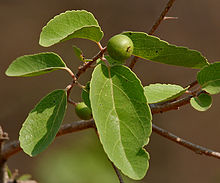Flacourtia indica
| Flacourtia indica | |
|---|---|

| |
| Scientific classification | |
| Kingdom: | Plantae |
| Clade: | Tracheophytes |
| Clade: | Angiosperms |
| Clade: | Eudicots |
| Clade: | Rosids |
| Order: | Malpighiales |
| Family: | Salicaceae |
| Genus: | Flacourtia |
| Species: | F. indica
|
| Binomial name | |
| Flacourtia indica (Burm.f.) Merr.
| |
| Synonyms | |
|
Flacourtia ramontchi | |
Flacourtia indica (syn. Flacourtia ramontchi), known commonly as ramontchi, governor's plum, Madagascar plum and Indian plum,[1] is a species of flowering plant native to much of Africa and tropical and temperate parts of Asia. F. indica and F. ramontchi are sometimes treated as separate species.
Description[]
This is a bushy shrub or tree with a spiny trunk and branches. In shrub form it grows up to 25 feet (7.6 m) and as a tree it reaches a maximum height around 50 feet (15 m). The drooping branches bear oval leaves. The seeds are dispersed by birds.[2] This tree has thorns similar to that of a lime or lemon tree. If in contact with the thorns, it leaves a nasty stinging pain.[citation needed]
Relatives[]
This section does not cite any sources. (October 2021) |
The family Salicaceae includes well-known species such as kei apple (Dovyalis caffra) louvi (Flacourtia inermis), paniala (F. jangomas), and rukam (F. rukam).
Uses[]
The ramontchi fruit itself is a pome about an inch thick and red ripening purple. It is very fleshy and has 6 to 10 seeds in layered carpels. The pulp is yellow or white and sweet with an acidic tang. It is eaten raw or made into jelly or jam. It can be fermented to make wine.[3]
The leaves and roots are used in herbal medicine for treatment of snakebite. The bark is believed to be effective for arthritis. Most parts of the plant are used for cough, pneumonia, and bacterial throat infection. It has also been used for diarrhea.
The tree is planted as a living fence; it was one of the species used for the Indian Inland Customs Line. The wood is used for firewood and small wooden tools such as plow handles.[3]
Cultivation[]
The plant is known as an occasionally invasive introduced species in some areas. It has been cultivated in Florida in the United States and today it occurs as a weed in some parts of the state.[4]
Notes[]
- ^ "Flacourtia indica (Burm. f.) Merr". Germplasm Resources Information Network (GRIN). Agricultural Research Service (ARS), United States Department of Agriculture (USDA). Retrieved 27 July 2016.
- ^ Pacific Island Ecosystems at Risk
- ^ a b World Agroforestry
- ^ "Flacourtia indica in Flora of North America @ efloras.org". www.efloras.org. Retrieved 2017-08-01.
References[]
- Morton, Julia F.; Fruits of Warm Climates; Julia F. Morton; Miami, FL, 1987.
- Popenoe, Wilson; Excluding The Banana, Coconut, Pineapple, Citrus Fruits, Olive And Fig (1920); The Macmillan Company, 1920.
External links[]
- Fruits originating in Africa
- Flacourtia
- Taxa named by Elmer Drew Merrill